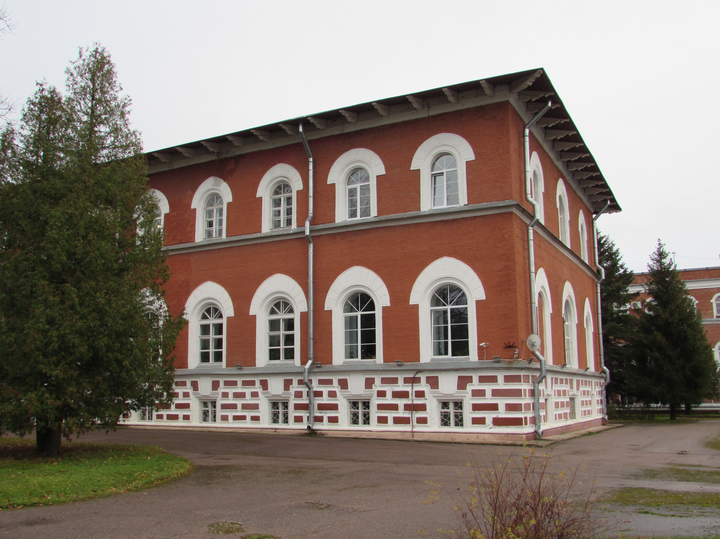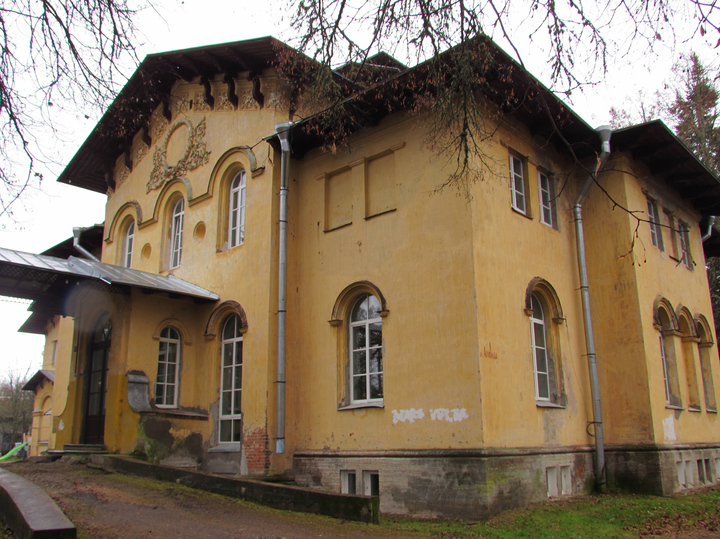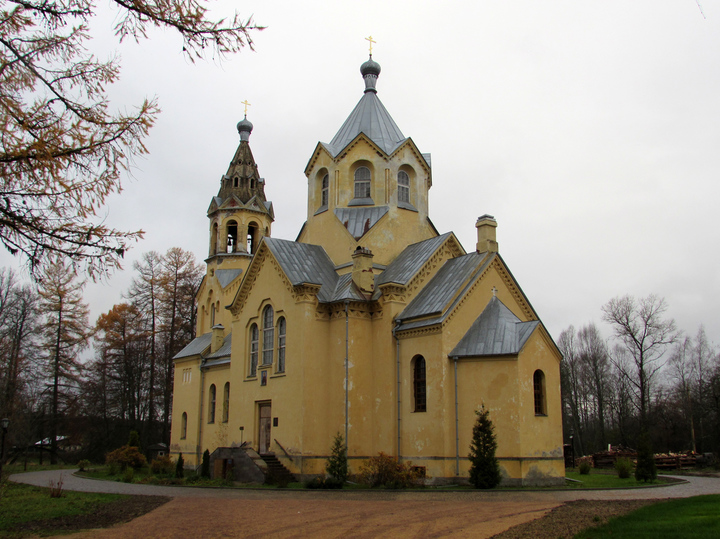Benois was born 210 years ago: the architect who built the “palace from the future”
[ad_1]
One of the most remarkable Russian architects, academician and “court architect” Nikolai Benois, has turned 210 years old. According to the designs of this master, many beautiful buildings were erected in St. Petersburg and its environs, and some of them actually anticipated the emergence of a new architectural style, which later became very popular in the West. The correspondent of “MK” got to the real “reserve”, where the unique buildings of Benois, which are still little known and visited, have been preserved.
The son of a French émigré who managed to become a head waiter at the court of Emperor Paul I, Nikolai Leontievich Benois showed remarkable ability to draw from childhood, in addition, Dowager Empress Maria Feodorovna was his godmother, and therefore it is not surprising that at the age of 14 the boy was accepted to full government boarding school to the Academy of Arts “for the study of architecture.” Benois graduated from a prestigious educational institution with honors – he received a Big Gold Medal for his graduation project.
After working for some time under the supervision of the famous architect Konstantin Ton, spending several years abroad, where he studied the architectural monuments of Italy, Germany, Austria, Nikolai Leontyevich was enrolled in the Cabinet of His Imperial Majesty upon his return to St. Petersburg. This institution was in charge of the personal property of the imperial family, ensured the fulfillment of the personal assignments of the monarch.
Sovereign Nikolai Pavlovich favored his namesake, the young architect. Therefore, Benois repeatedly received various tasks from him. And in August 1847, Nikolai Leontievich was asked to prepare the first major architectural project in his practice: the tsar wanted to create a new complex of palace stables in Peterhof, indicating that they should be made in the so-called Gothic style.
Fulfilling the royal order, Benois came up with a very advantageous solution for the layout of the buildings of the arena. The architect arranged them one after another, designing a portal with a passage gate in the center of each building. As a result, a spectacular perspective opened up from the main entrance with a “chain” of identically designed gates going deep into the entire complex.
However, the emperor did not appreciate such an idea of the master. After looking at the drawings submitted for approval, he made a note on paper: move the forge building, placing it just along the axis of the gate. Such a royal innovation destroyed the entire visual effect: the forge blocked the whole perspective.
Nikolai Leontyevich understood that his idea was thus completely destroyed. In desperation, he took a non-standard move, hoping to convince the emperor. The architect made two watercolor drawings. On one he depicted the perspective he had conceived with a string of gates in three buildings, and on the other he showed what an unsightly view would open from the same main entrance if the notorious smithy was placed behind it in the courtyard.
The architect took both watercolors to the emperor’s waiting room. However, Prince P. Volkonsky, who received correspondence for the monarch, realizing that in this case it was an attempt to contradict the will of His Majesty, did not want to carry these pictures for the highest approbation. Only with great difficulty did Nikolai Leontievich manage to convince him to carry out such an assignment.
At the same time, the architect himself took a great risk. Everyone knew the tough temper of Nicholas I: the monarch used to punish very severely for violations of his orders. But this time, Benois’ “tactical move” worked: the watercolors were very convincing. A few minutes later, Prince Volkonsky left the royal office with a smile: “The sovereign laughed a lot at your insolence, but agreed to do it your way!”
In the same Peterhof, according to the projects of Nikolai Leontyevich, a postal complex, as well as a railway station, were later erected. This building is recognized as one of the most beautiful stations in all of Europe.
Several very interesting buildings designed by N. Benois appeared in the village of Lisino, located 70 kilometers south of St. Petersburg. These sights are still far from the traditional tourist routes.
In the 1830s here, on the territory of a huge forest area – the Lisinsky forest state dacha, it was decided to open a specialized educational institution – the Jaeger School “to train people knowledgeable in forestry.” In addition, the environs of Lisin, teeming with game, soon became one of the favorite hunting grounds for members of the imperial family, including Tsarevich Alexander Nikolaevich.

It was under the patronage of the heir to the throne in 1852 that Nikolai Benois was given the task of preparing a project for a new stone educational building for future huntsmen. Thus began his “Lisinsky” period of creativity, stretching for 10 years. As a result, Nikolai Leontievich “marked” himself in Lisino with three interesting buildings. This original ensemble has survived to this day and includes an educational building for trainees of the Forestry Institute (1855), the Temple of the Origin of the Honest Trees of the Life-Giving Cross of the Lord (1862), and the imperial hunting palace (1860).
The attention of a few tourists who get to the village (its current name is Lisino-Korpus) is immediately attracted by the territory of the Forest College located here, which evokes associations with a real estate. In the middle stands a spectacular red-and-white brick building, which one would like to call a palace. In fact, this is the same educational building, built according to the project of N. Benois and surrounded by several wooden buildings. The real palace, the hunting residence of Emperor Alexander II, is located 200 meters to the left. It is hidden by the overgrown trees of the old park.
Having designed the palace in Lisino, Nikolai Benois made a real “breakthrough in time”. For the late 1850s – early 1860s. this building looked very unusual. Only years later, a similar style, called “modern”, became popular in European architecture.

In the “house for the arrival of the highest persons” Benois designed a separate “imperial” wing. Here were the sovereign’s office, a billiard room and a bedroom. Actually, three bedrooms.
Once in this room, the MK correspondent drew attention to the peculiarity of its layout. Spacious niches are equipped in three walls at once. Each of them, according to the architect’s idea, was intended to place a bed where the “August hunter” could settle down for the night. That is, Alexander II had the opportunity every time to choose in which of the niches-bedrooms to settle down. None of the other inhabitants of the palace knew about the specific “royal deployment”. Thus, Nikolai Benois in his project provided for the possibility of ensuring the safety of His Majesty from hypothetically possible nighttime assassination attempts by the conspirators.

Another notable building of N. Benois in Lisino is the local temple, which is made in the “Russian-Byzantine” style. His original drawing, made by the architect himself, has been preserved. A sheet of thick paper is labeled: “The project of the Orthodox Church in the Lisinsky educational forestry.” And next to the image of the cult building, the author’s comment is placed: “During the presence of the Sovereign Emperor in L.U.L. On the evening of October 20, 1858, His Majesty, after considering this project, was pleased to say to me: “I really like this Church.” Architect N. Benois.
In addition to the church building itself, Nikolai Leontievich also designed all the elements of its interior decoration, including a carved oak iconostasis.
Residents of St. Petersburg and guests of the Northern capital can admire many wonderful works of the architect Benois. Among them, for example, the famous Bolshoi Gostiny Dvor (the main facade of this iconic building for the “city on the Neva”, overlooking Nevsky Prospekt, was modified and received its current design precisely according to the project of Nikolai Leontyevich). The authorship of Nikolai Benois also owns several mansions and apartment buildings on the Moika embankment, Liteiny and Ligovsky prospects, Admiralteyskaya embankment …
[ad_2]
Source link






